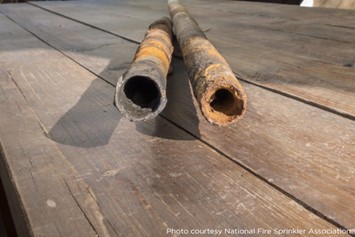Identifying and Preventing MIC in Fire Sprinkler Systems

Identifying and Preventing MIC in Fire Sprinkler Systems
Fire Sprinkler systems protect people and property. We hope we never need them, but how do we know that they will operate when we do? A comprehensive sprinkler system maintenance and testing program should be implemented. However, one often overlooked component is the water itself.
Most people are not aware of the effects that microorganisms can have on a fire sprinkler system. One condition that is not easily detected and that can decrease the effectiveness of a sprinkler system is call Microbiologically Influenced Corrosion, or MIC.
What is MIC?
MIC corrosion occurs inside the sprinkler system from a specific bacterium (microorganisms) that can be found in water. Once the water enters the metal piping, the bacteria feed on the metal, resulting in premature deterioration of the system’s metal components. MIC concentrates and accelerates the rate of corrosion. It causes inconsistencies in the pipe’s interior such as pits, crevices, craters and obstructions. The corrosion can lead to two major failures in the sprinkler system.
- Leaks such as pinholes in the piping
- Obstructions that will cause the system to fail or not operate as intended - which could lead to property loss or loss of life
MIC is a contributing force in the corrosion of wet pipe, dry pipe and pre-action systems.
Identifying MIC
It is possible that a sprinkler system may have developed MIC and it is not caught by the building owner or the sprinkler contractor until leaks or obstructions occur. Some visual signs of MIC include moisture on the piping exterior, blistering of paint on the piping and pinhole leaks. Additionally, the odor and color of the pipe water and presence of slime in the water is another trait of MIC. MIC may appear anywhere from 5-20 years in age of a fire sprinkler system, and it may occasionally occur in new systems that are less than a year old.
Prevention and Control Methods
To address MIC in existing and new systems, Nationwide Loss Control Services recommends that you consult with a third-party contractor that specializes in MIC as it applies to fire sprinkler systems. Some methods of prevention and controls that are recognized from specialists include:
- The water for new sprinkler systems should be tested for MIC related bacteria before filling the system; If found, MIC prevention methods should be developed before the new system’s initial fill up
- On existing sprinkler systems with MIC, flush the sprinkler system to eliminate the MIC-induced corrosion and follow with a formal treatment plan
- Infected sections of piping may be replaced with new piping on existing systems and control methods developed to prevent future pipe damage
- The most common method of treatment is to implement a MIC water treatment plan that uses biocides; MIC can develop immunity to the biocides over time, though, and a shift to new biocides will be needed
- Consider a biodegradable MIC treatment that is environmentally friendly
- Consider treatments that are safe for occupied spaces and the environment; The chemicals used to treat the MIC should be non-toxic in event of a discharge
- Schedule professional periodic MIC inspections and water tests for both new and existing systems
Additional Resources
NFPA Handbook, Supplement 3: MIC in Fire Sprinkler Systems
NFSA: An Introduction to Corrosion in Sprinkler Systems
Buildings.com: Safety Corroded - Why Your Fire Sprinkler System May Be at Risk
